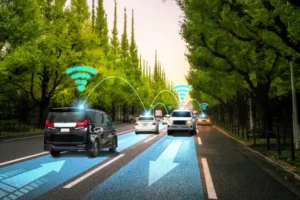Navigating the road to autonomous vehicles involves a complex journey filled with challenges and promises. Autonomous vehicles, often referred to as self-driving cars, have the potential to revolutionize transportation by improving safety, efficiency, and accessibility.
However, achieving widespread adoption and realizing their full potential is not without its hurdles. Here are some of the key challenges and promises associated with autonomous vehicles:
Navigating the Road to Autonomous Vehicles
Challenges:
Safety Concerns
Ensuring the safety of autonomous vehicles is paramount. While they have the potential to reduce accidents caused by human error, they can introduce new risks, such as software glitches, sensor limitations, and challenges in navigating complex environments.
- Read More: The Rise of Electric SUVs: Redefining Family Travel
- Read More: The Classic Car Renaissance: Why Vintage Automobiles Never Go Out of Style
Regulatory and Legal Frameworks
Developing and implementing a regulatory framework for autonomous vehicles is a complex task. Government agencies must establish standards for vehicle safety, data privacy, and liability in case of accidents.
Infrastructure and Connectivity
Autonomous vehicles rely on robust infrastructure, including high-definition maps, real-time data, and communication networks. Building and maintaining this infrastructure can be costly and time-consuming.
Technical Challenges
Developing reliable and robust sensor and control systems, machine learning algorithms, and artificial intelligence (AI) models is challenging. Autonomous vehicles must adapt to dynamic and unpredictable road conditions, weather, and human drivers.
Ethical and Moral Dilemmas
Autonomous vehicles may face situations where they must make moral decisions in emergencies. For example, should a self-driving car prioritize the safety of its passengers or pedestrians in a potential collision scenario?
- Read More: Top 12 University in USA
- Read More: Choosing the Best University at USA
Cybersecurity
The increasing connectivity of vehicles makes them vulnerable to cyberattacks. Protecting autonomous vehicles from hacking and data breaches is a critical concern.
Public Acceptance
Convincing the public to trust and adopt autonomous vehicles can be a significant challenge. Building public awareness and addressing concerns about job displacement, data privacy, and the loss of driving enjoyment are important aspects of public acceptance.
Promises:
Safety Improvements
Autonomous vehicles have the potential to significantly reduce accidents caused by human error, such as distracted driving, speeding, and impaired driving.
Efficiency and Traffic Management
Self-driving cars can optimize traffic flow, reduce congestion, and minimize fuel consumption by communicating with other vehicles and traffic management systems.
Accessibility
Autonomous vehicles can provide mobility solutions for individuals who are unable to drive, such as the elderly and disabled. They can enhance accessibility and reduce the need for car ownership.
Environmental Benefits
Autonomous vehicles can promote more efficient driving, reducing fuel consumption and greenhouse gas emissions. Electric autonomous vehicles can further contribute to environmental sustainability.
Improved Transportation Services
Autonomous vehicles can revolutionize public transportation and logistics by providing cost-effective and on-demand services, making transportation more convenient and affordable.
- Read More: How to get Free Insurance?
- Read More: 10 Most Expensive Cars in the World in 2023
Economic Opportunities
The development and deployment of autonomous vehicles can create new economic opportunities in industries related to vehicle manufacturing, software development, data analytics, and infrastructure development.
Urban Planning and Land Use
Autonomous vehicles may lead to changes in urban planning, with less need for parking spaces, reduced traffic congestion, and the potential for more green spaces in cities.
Conclusion
Navigating the road to autonomous vehicles is a complex and multifaceted journey. While the challenges are significant, the promises of improved safety, efficiency, and accessibility make it a worthwhile endeavor. Successful adoption will require collaboration among governments, industry stakeholders, and the public to address the challenges and realize the full potential of autonomous vehicles.






